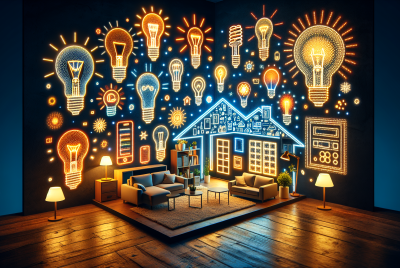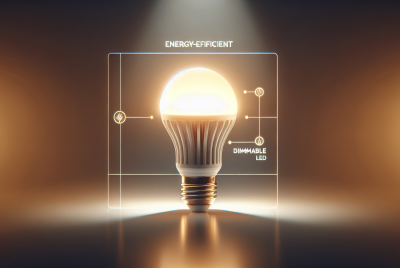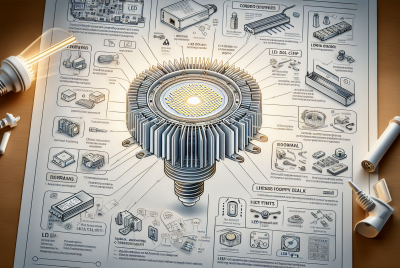How To Choose The Right LED Bulbs For Your Home
You’re in search of the perfect LED bulbs for your home, but with so many options out there, it can be overwhelming to make a decision. Don’t worry, we’ve got you covered. In this article, we’ll guide you through the process of choosing the right LED bulbs for your home, taking into consideration factors such as brightness, color temperature, and energy efficiency. By the time you finish reading, you’ll be equipped with all the knowledge you need to brighten up your space with the perfect LED bulbs.

Factors to Consider when Choosing LED Bulbs
Choosing the right LED bulbs for your home can significantly impact both the aesthetics and functionality of your space. With so many options available in the market, it is important to consider a few key factors before making your purchase. In this article, we will explore the important factors to consider when choosing LED bulbs, including brightness, color temperature, and energy efficiency.
Brightness
When it comes to lighting, brightness is a critical factor to consider. LED bulbs are available in various levels of brightness, which are measured in lumens. The higher the number of lumens, the brighter the light output. When choosing LED bulbs for your home, take into account the brightness needed for the specific room or area where the bulbs will be installed. For example, a kitchen or workspace may require brighter bulbs to ensure good visibility, while a bedroom or living room may benefit from softer, more ambient lighting.
Color Temperature
The color temperature of LED bulbs refers to the appearance of light produced by the bulb. It is measured in Kelvin (K) and can range from a warm yellowish light to a cool bluish light. The color temperature you choose largely depends on the ambiance you want to create in a specific area of your home. Lower color temperatures, usually ranging from 2700K to 3000K, offer a warm and cozy light, ideal for bedrooms and living rooms. On the other hand, higher color temperatures, typically ranging from 4000K to 5000K, provide a crisper and more energizing light, perfect for kitchens and workspaces.
Energy Efficiency
Energy efficiency is a crucial consideration when choosing LED bulbs. LED bulbs are known for their energy-saving capabilities compared to traditional incandescent bulbs. To ensure maximum energy efficiency, look for bulbs with the Energy Star certification. These bulbs have undergone rigorous testing to meet the highest standards for energy efficiency and performance. By choosing energy-efficient LED bulbs, you can not only reduce your energy consumption but also save money on your utility bills in the long run.
Understanding Lumens and Watts
Lumens and watts are important measurements that can help you understand and compare the brightness and energy efficiency of LED bulbs.
Lumens: Lumens measure the total amount of visible light emitted by a bulb. The higher the number of lumens, the brighter the light output. When choosing LED bulbs, it is important to consider the lumens needed for a specific area, taking into account factors such as room size and the desired level of brightness.
Watts: In the past, wattage was used to determine the brightness of traditional incandescent bulbs. However, with LED bulbs, wattage does not directly correspond to brightness. Instead, it indicates the amount of power consumed by the bulb. When comparing LED bulbs, pay attention to the lumens rather than the wattage to ensure you select the desired level of brightness.
Choosing the Right Bulb Shape and Size
LED bulbs come in various shapes and sizes, each with its own unique characteristics and applications. Understanding the different bulb shapes and sizes can help you make an informed decision for your specific lighting needs. Let’s explore some common bulb shapes and sizes:
A19 Bulbs
A19 bulbs are the most common and versatile type of LED bulbs. They have a traditional bulb shape and are commonly used in lamps, ceiling fixtures, and sconces. The size of A19 bulbs is standardized, making it easy to find compatible fixtures.
BR30 Bulbs
BR30 bulbs, also known as reflector bulbs, are designed with a wider light spread. They are typically used in recessed lighting fixtures and track lighting. BR30 bulbs are ideal for illuminating larger areas, such as living rooms and kitchens.
Candelabra Bulbs
Candelabra bulbs have a unique and decorative shape, resembling a mini candle flame. They are commonly used in chandeliers, sconces, and decorative light fixtures. Candelabra bulbs are available in various sizes and wattages, allowing you to create a warm and elegant ambiance in your home.
Globe Bulbs
Globe bulbs, as the name suggests, have a spherical shape. They are often used in pendant lights and bathroom vanity fixtures. Globe bulbs provide a soft and diffused light, creating a cozy and inviting atmosphere.
Floodlight Bulbs
Floodlight bulbs are designed to project a wide beam of light over a large area. They are commonly used for outdoor lighting, such as security lights and landscape lighting. Floodlight bulbs are available in various sizes and brightness levels, allowing you to enhance the safety and visibility around your home.
Tube Bulbs
Tube bulbs, also known as T8 bulbs, are long and cylindrical in shape. They are commonly used in fluorescent fixtures and can be a direct replacement for traditional fluorescent tube lights. Tube bulbs are energy-efficient and provide a bright and even light output, making them suitable for offices, garages, and other commercial spaces.
Selecting the Appropriate Base Type
The base type of an LED bulb determines how it will connect and fit into a light fixture. It is important to select the appropriate base type to ensure compatibility with your existing fixtures. Let’s explore some common base types for LED bulbs:
E26 Base
The E26 base, also referred to as the medium base, is the most common base type for household lighting fixtures. It has a screw-in design and is compatible with a wide range of fixtures, including table lamps, floor lamps, and ceiling fixtures.
E12 Base
The E12 base, also known as the candelabra base, is commonly used in smaller decorative fixtures and chandeliers. It has a smaller screw-in design compared to the E26 base and is characterized by its unique flame-shaped bulb.
GU10 Base
The GU10 base is primarily used in track lighting and recessed lighting fixtures. It has a twist-and-lock design and is known for its stability and ease of installation. GU10 bulbs are often used to accent specific areas or objects in a room.
MR16 Base
The MR16 base is similar to the GU10 base but with two pins instead of a twist-and-lock design. It is commonly used in accent lighting, display cases, and track lighting. MR16 bulbs provide a focused beam of light and are available in various beam angles.
G9 Base
The G9 base is used primarily in smaller decorative fixtures and bathroom vanity lighting. It has a two-pin design and is characterized by its compact size. G9 bulbs are ideal for areas where space is limited, such as sconces and small chandeliers.

Deciding on the Color Rendering Index (CRI)
The Color Rendering Index (CRI) is a measure of how well a light source renders colors compared to natural daylight. The index ranges from 0 to 100, with higher values indicating better color rendering. When choosing LED bulbs, consider the CRI if color accuracy is essential in the application. For example, if you want to showcase artwork or use makeup in a well-lit bathroom, opt for bulbs with a high CRI to ensure accurate color representation.
Considering the Dimming Capability
If you prefer the flexibility to adjust the brightness of your lighting, consider LED bulbs with dimming capabilities. Not all LED bulbs are dimmable, so it is important to check the packaging or product specifications to ensure compatibility with dimmer switches. Dimmable LED bulbs can enhance the atmosphere of a room and allow you to create different lighting levels to suit your preference and mood.
Determining the Beam Angle
The beam angle of an LED bulb determines the width and direction of the light beam it emits. It is measured in degrees and can range from narrow spotlights to wide floodlights. The beam angle you choose depends on the specific area you want to illuminate and the intended purpose. For example, a narrow beam angle is ideal for accent lighting, highlighting artwork or architectural features, while a wider beam angle is suitable for general lighting, evenly illuminating larger areas.
Reviewing the Lifespan and Warranty
LED bulbs are renowned for their long lifespan compared to traditional incandescent bulbs. When selecting LED bulbs, review the estimated lifespan provided by the manufacturer. A longer lifespan will ensure reduced maintenance and replacement costs over time. Additionally, consider the warranty offered by the manufacturer. A reputable brand will often provide a warranty that guarantees the performance and quality of their LED bulbs, giving you peace of mind in your purchase.
Calculating the Cost and Payback Period
While LED bulbs may have a higher upfront cost compared to traditional bulbs, they offer significant energy savings over the long run. To determine the cost effectiveness of LED bulbs, calculate the payback period, which is the time it takes for the energy savings to offset the higher initial investment. Consider factors such as the energy savings per year and the lifespan of the bulb to estimate the payback period. In most cases, LED bulbs pay for themselves within a few years, making them a cost-effective choice in the long term.
Conclusion
Choosing the right LED bulbs for your home involves considering factors such as brightness, color temperature, and energy efficiency. By understanding the differences in lumens and watts, selecting the appropriate bulb shape and size, and choosing the right base type, you can find LED bulbs that perfectly suit your lighting needs. Additionally, factors such as color rendering index, dimming capability, beam angle, lifespan, warranty, and cost can further enhance your selection process. With a wide range of LED bulb options available, take the time to explore and compare different products to ensure you create the perfect lighting experience for your home.




